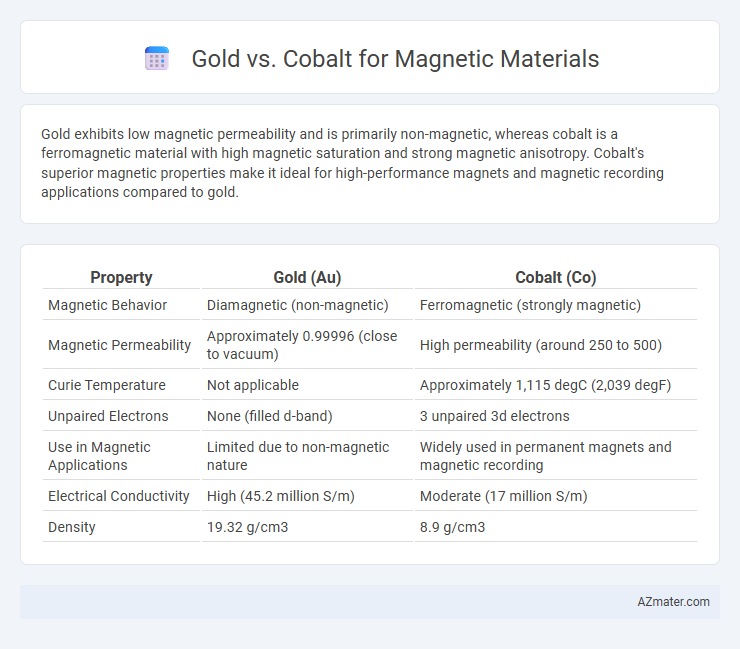Gold exhibits low magnetic permeability and is primarily non-magnetic, whereas cobalt is a ferromagnetic material with high magnetic saturation and strong magnetic anisotropy. Cobalt's superior magnetic properties make it ideal for high-performance magnets and magnetic recording applications compared to gold.
Table of Comparison
| Property | Gold (Au) | Cobalt (Co) |
|---|---|---|
| Magnetic Behavior | Diamagnetic (non-magnetic) | Ferromagnetic (strongly magnetic) |
| Magnetic Permeability | Approximately 0.99996 (close to vacuum) | High permeability (around 250 to 500) |
| Curie Temperature | Not applicable | Approximately 1,115 degC (2,039 degF) |
| Unpaired Electrons | None (filled d-band) | 3 unpaired 3d electrons |
| Use in Magnetic Applications | Limited due to non-magnetic nature | Widely used in permanent magnets and magnetic recording |
| Electrical Conductivity | High (45.2 million S/m) | Moderate (17 million S/m) |
| Density | 19.32 g/cm3 | 8.9 g/cm3 |
Introduction to Magnetic Materials: Gold vs Cobalt
Gold and cobalt exhibit fundamentally different magnetic properties due to their atomic structures. Cobalt is a ferromagnetic material with a high Curie temperature around 1,115degC, making it ideal for permanent magnets and magnetic recording media. In contrast, gold is diamagnetic and does not retain magnetization, limiting its use in magnetic applications but offering excellent conductivity and corrosion resistance for electronic components.
Fundamental Magnetic Properties of Gold and Cobalt
Cobalt exhibits strong ferromagnetic properties due to its unpaired 3d electrons, resulting in high saturation magnetization and significant coercivity, essential for permanent magnets and magnetic storage. Gold, a diamagnetic metal with fully filled electron shells, shows no intrinsic magnetic ordering and weakly repels magnetic fields. Fundamental differences arise from cobalt's ferromagnetic exchange interactions versus gold's lack of unpaired spins, influencing their applications in magnetic materials.
Atomic Structure and Magnetism: Comparing Gold and Cobalt
Cobalt's atomic structure features unpaired 3d electrons that produce a strong ferromagnetic behavior, making it highly magnetic and essential in permanent magnets and magnetic storage devices. Gold, with its filled 5d electron shell and paired electrons, exhibits diamagnetism, meaning it weakly repels magnetic fields and lacks intrinsic magnetic ordering. The contrasting electron configurations between cobalt and gold directly influence their magnetic properties, with cobalt's partially filled d-orbitals driving robust magnetism and gold's filled orbitals resulting in negligible magnetic response.
Applications of Gold-Based Magnetic Materials
Gold-based magnetic materials exhibit exceptional chemical stability and biocompatibility, making them ideal for applications in biomedical imaging, targeted drug delivery, and biosensors. Their superior corrosion resistance and easy functionalization enhance performance in magnetic resonance imaging (MRI) contrast agents and hyperthermia treatments for cancer. These properties position gold-based magnetic materials as a critical component in advanced medical diagnostics and therapeutic technologies.
Industrial Uses of Cobalt in Magnetics
Cobalt is extensively used in the production of high-performance permanent magnets, such as samarium-cobalt (SmCo) magnets, valued for their exceptional magnetic strength and thermal stability in industrial applications. Unlike gold, which has limited magnetic properties and is primarily used in electronics for corrosion-resistant contacts, cobalt's magnetic alloys are critical in manufacturing electric motors, wind turbine generators, and aerospace components. The industrial significance of cobalt in magnetics stems from its ability to maintain magnetization at elevated temperatures, making it indispensable for advanced magnetic materials.
Conductivity and Magnetic Performance: Key Differences
Gold exhibits excellent electrical conductivity but is diamagnetic, making it unsuitable for magnetic applications requiring strong magnetic response. Cobalt combines moderate conductivity with robust ferromagnetic properties, enabling efficient magnetic performance in devices such as hard drives and motors. The key difference lies in cobalt's ability to maintain magnetization, while gold primarily serves in conductive roles without contributing to magnetic functionality.
Cost and Availability: Gold versus Cobalt for Magnetic Applications
Gold exhibits extremely low magnetic susceptibility but comes at a significantly higher cost, limiting its practical use in magnetic applications. Cobalt, while moderately priced, offers strong magnetic properties and is more abundantly available, making it the preferred choice for high-performance magnetic materials. The cost-effectiveness and accessibility of cobalt drive its widespread adoption in industrial magnets and electronic devices compared to the expensive and scarce gold.
Environmental and Health Impacts of Gold and Cobalt Usage
Gold extraction often involves toxic chemicals like cyanide and mercury, causing significant environmental contamination and health risks, including water pollution and occupational hazards. Cobalt mining is associated with habitat destruction and severe human rights concerns, especially in regions with artisanal and small-scale mining, exposing workers to respiratory diseases and toxic dust. Sustainable sourcing and improved regulations are critical to mitigating the environmental degradation and health impacts linked to both gold and cobalt usage in magnetic materials.
Research Trends: Innovations in Gold and Cobalt Magnetics
Research trends highlight significant innovations in gold and cobalt magnetics, with cobalt alloys demonstrating superior magnetic properties ideal for high-performance applications such as electric vehicle motors and data storage devices. Gold's unique surface plasmon resonance is being explored to enhance magnetic sensor sensitivity and enable novel spintronic devices leveraging gold-cobalt interfaces. Advances in nanostructuring and doping techniques are pushing the boundaries of magnetic efficiency and thermal stability in both metals, driving breakthroughs in multifunctional magnetic materials.
Future Prospects: Which Metal Leads in Magnetic Materials?
Cobalt remains the preferred choice for magnetic materials due to its superior ferromagnetic properties, high Curie temperature, and strong coercivity, making it essential in high-performance magnets for electric vehicles and renewable energy technologies. Gold, while excellent for corrosion resistance and electrical conductivity, lacks intrinsic magnetic characteristics and is primarily used in electronics for conductive coatings rather than magnetic applications. Future prospects strongly favor cobalt as the leading metal in magnetic materials, driven by increasing demand in advanced energy storage and motor technologies.

Infographic: Gold vs Cobalt for Magnetic Material
 azmater.com
azmater.com